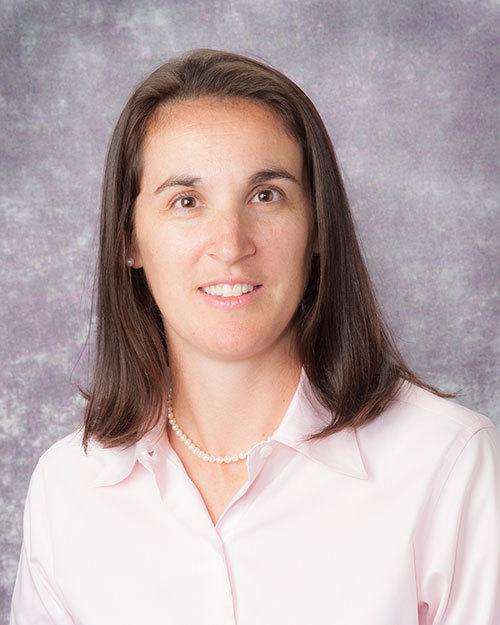After a Decade of Disabling Pain, Young Woman Finds New Lease on Life with Magee Physician

Dr. Nicole Donnellan helps patients find relief from the unbearable symptoms of endometriosis
For many of us, the transition from adolescence to young adulthood was a time of discovery. We attended high school dances and college football games. We met new people, tried new activities and traveled to interesting places.
But for 25-year-old Hilary Flint of Enon Valley, PA, life during her teens and early twenties was not so enjoyable. While her peers went to parties and the mall, Hilary was often bedridden for days, doubled over with pain so severe she could barely walk.
Although she didn’t know it at the time, Hilary was suffering from the intense pain of endometriosis. Her symptoms started in elementary school, after she began menstruating at age nine. From that point on, doctors told Hilary her debilitating pain was simply “part of being a woman.”
It took more than a decade before Hilary heard the word “endometriosis” for the first time. After ten years of withdrawing from daily life, she met a physician who said what she’d been craving to hear: “Your pain is real. Your condition is not imaginary. And I can help you.”
A common condition with an enormous toll
Endometriosis is a medical condition that affects one in 10 women of reproductive age.
Every woman has endometrial tissue inside her uterus. Every month it thickens, breaks down and exits the body with the menstrual flow. But in women with endometriosis, this tissue grows outside of the uterus. It implants throughout the pelvis, including the ovaries, fallopian tubes, bladder and bowel. The displaced endometrium builds up and forms scar tissue.
Endometriosis can cause chronic pain and other symptoms, including:
- Painful periods
- General pelvic pain outside of menstrual cycles
- Painful intercourse
- Painful bowel movements
- Infertility
For Hilary, endometriosis meant pain and bleeding three weeks of every month. Coupled with this physical pain was constant anxiety, knowing the pain would return.
“When I was 19, I moved to Toronto to attend college,” Hilary says. “That’s when I first realized other women were not going through this. But learning my symptoms were not normal did not make them any more bearable. I sometimes couldn’t leave my house for 10 days at a time, so I took entire semesters off. I finally had to leave school and finish my degree online.”
Hilary says the constant worrying about missing school and work caused her to stop making plans altogether. There was no point in committing to anything. Until she could get her pain under control, her pain was in control.
Then she met Nicole Donnellan, MD, a gynecologist and minimally invasive gynecologic surgeon at Magee-Womens Hospital of the University of Pittsburgh Medical Center (UPMC).
A chance meeting leads to a second chance at life

Hilary’s relationship with Dr. Donnellan began with a faulty gallbladder.
In 2014, UPMC general surgeon Giselle Hamad, MD, scheduled Hilary for gallbladder removal. Dr. Hamad suspected Hilary’s gallbladder was causing only a fraction of her ongoing pain. She recommended Hilary consult with Dr. Donnellan, who specializes in unexplained pelvic pain and other gynecologic conditions.
“I had a unique opportunity to examine Hilary during her gallbladder surgery,” says Dr. Donnellan. “The only way to confirm endometriosis is through laparoscopic surgery, where we look inside the body for evidence of endometrial scar tissue. That day, I ruled out other medical conditions that cause pelvic pain. And we spared Hilary having a second surgery simply to verify she has endometriosis.”
Hilary says from the very beginning, Dr. Donnellan was honest about the challenges of treating endometriosis.
“She explained there isn’t a one-size-fits-all cure, and there would be some trial and error in finding the treatment that works for me,” says Hilary. “Even though I would have preferred a quick solution, I was grateful to find someone who didn’t dismiss my symptoms. She acknowledged that endometriosis impacts women in profound ways.”
Hilary’s treatment journey did take time. But today she is mostly pain-free, thanks to a three-pronged approach:
- Laparoscopic surgery. In 2015, Dr. Donnellan surgically removed the scar tissue from Hilary’s pelvic area.
- Hormonal therapy. Hilary has an intrauterine device (IUD) along with a second, long-term birth control implant. Together they’ve fully stopped her periods. This helps eliminate pain and prevent additional scar tissue from forming.
- Pelvic floor physical therapy. Specialized exercises strengthen the vaginal and abdominal wall muscles. If the pelvic floor weakens, it can cause pain.
“This is the first time I’ve felt like a fully functioning human being,” says Hilary. “I have a full-time job that I enjoy, I can make plans for the weekend and go on a real vacation. It has been the most satisfying and productive year of my life.”
Freeing women from physical pain and emotional anguish
Hilary’s story may surprise some, but to Dr. Donnellan it’s all too familiar. She says the average length of time for a woman to be diagnosed with endometriosis is eight to 11 years.
“We’ve learned how to manage endometriosis, but we still don’t know why it occurs or who is at risk,” explains Dr. Donnellan. “We spend a lot of time and money trying to figure out the cause of pelvic pain, putting patients through ineffective treatments in the process. If we could take the guesswork out of diagnosis, we’d spare women years of unnecessary suffering.”
Outside of her busy clinical practice, Dr. Donnellan is tackling these very questions. As a clinical investigator with Magee-Womens Hospital of UPMC and the University of Pittsburgh School of Medicine, she is studying why some women get endometriosis but others don’t.
In 2010, Dr. Donnellan launched a prospective study to collect blood and endometrial tissue from women undergoing laparoscopic surgery. By examining living tissue specimens, she and her colleagues can analyze certain inflammatory markers. And by better understanding the inflammatory response in endometrial tissue, she may learn how a woman’s immune system influences establishment and proliferation of the disease.
Game-changing research may lead to a life-changing solution
Building on her previous research identifying microRNAs as a biomarker for endometriosis, Dr. Donnellan also hopes to create a simple blood test that screens for the condition.
“If we can establish screening mechanisms for early detection, it would allow primary care doctors to refer patients directly to an endometriosis specialist,” she adds. “We could dramatically decrease the existing delay in diagnosis, and help countless women who are trying to cope with severe chronic pain or infertility.”
In the meantime, she’s helping patients like Hilary get their lives back—one grateful woman at a time.
“Never underestimate the impact of finding a doctor who listens,” says Hilary. “I’d been asking for help for a decade by the time I met Dr. Donnellan, but she was the first person who actually heard me. That’s how I knew I could trust her with my care. And I feel very blessed to have done so.”
Be the First to Know
Get the latest research, news, events, and more delivered to your inbox.